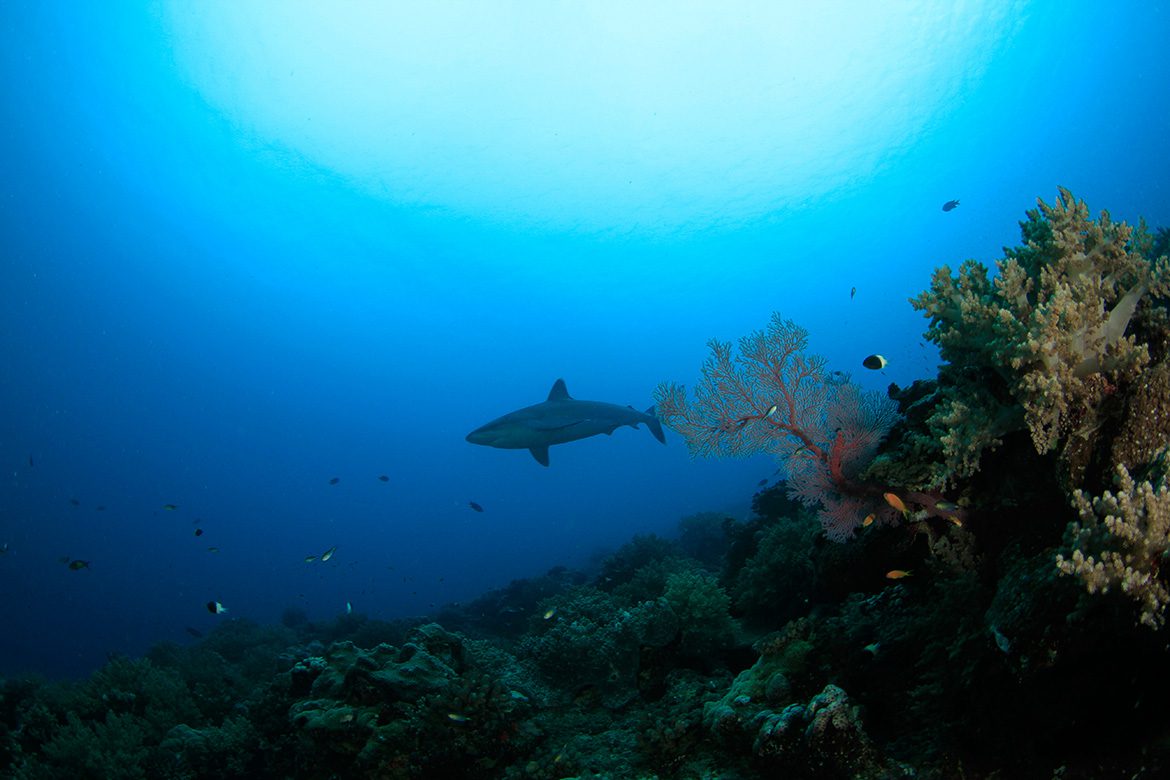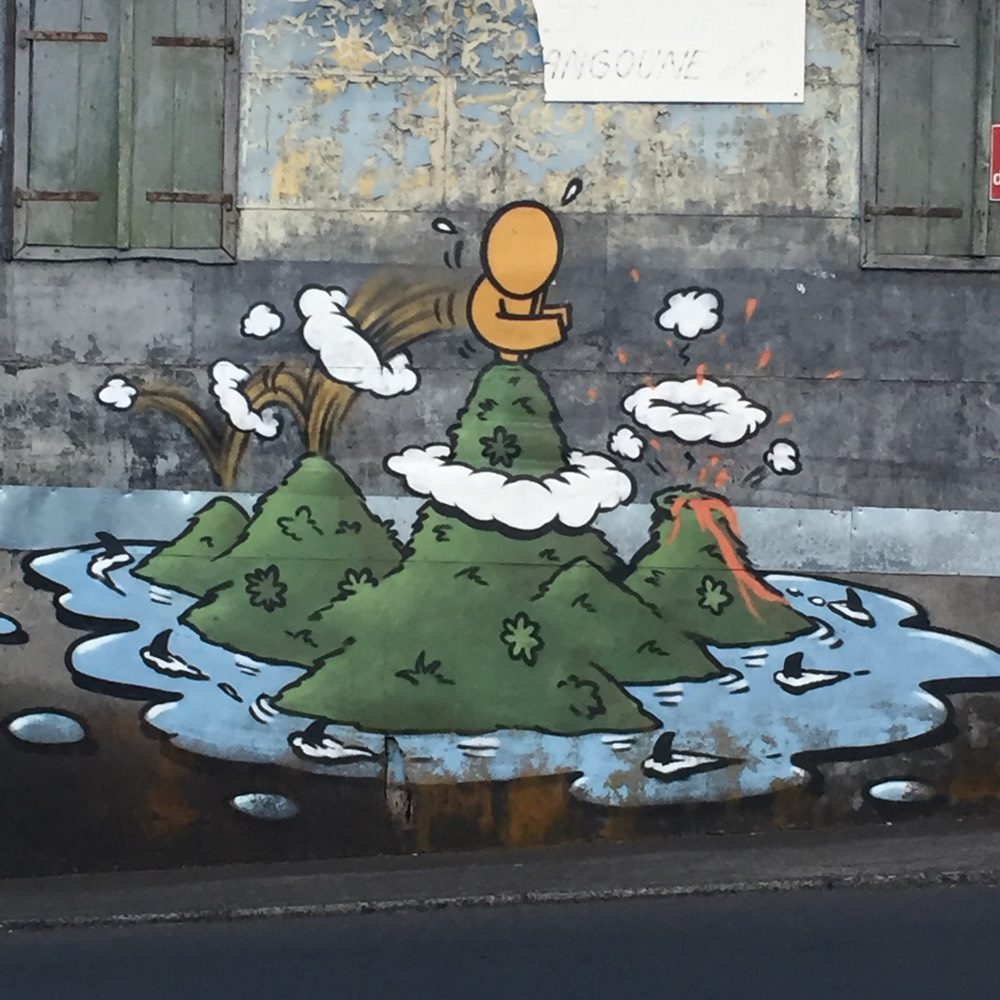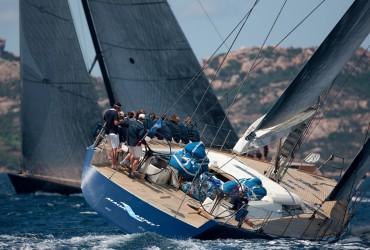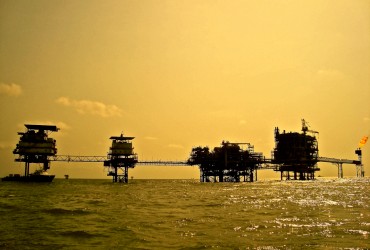More than a hobby for Zoreils
As usual on the west coast of Réunion Island, the weather is nice and hot. Friday December 11th, 2015, makes no exception. It’s a special day nonetheless. Reporters from local newspapers have all gathered on the glass-bottom boat Le Grand Bleu for the inauguration of the brand new anti-shark netting system in Boucan Canot. Patrick Flores picks the microphone up to address the attentive crowd: “We are the witnesses of a historical moment. Today, we continue a legacy of marine activities that started more than 40 years ago on our island.” Patrick Flores is a known and respected member of the community. He grew up in Boucan Canot and is the father of Jeremy’s Flores, France’s number one surfer. He was lately elected as assistant mayor of Saint-Paul, but keeps his role as a coach for France’s surfing team.
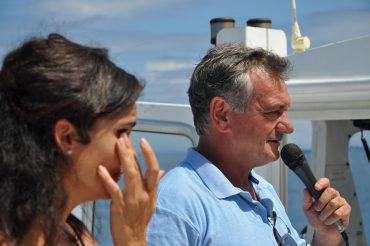 Patrick Flores worked hard for many months to safely put people back in the waters of Réunion Island. His idea is very effective: a state-of-the-art, custom-built, non-trapping mesh that secures 84’000 square meters of salt water. Boucan Canot now has a surfing and swimming zone the size of 67 Olympic pools, guaranteed shark-free. Tourists and islanders can finally enjoy the waves once again. It’s an emotional moment. “My thoughts go to the victim’s families, says Patrick Flores into the microphone. I feel extremely happy to see this project come to life today, but it’s hard not to think about the people that we lost along the way. Before I’m not able to speak anymore, I officially declare the marine activities open!” he exclaims at 10.15 am precisely. His speech is followed by the deep sound of the boat’s horn. On the beach, the lifesavers answer the call by raising up the very first green surfing flag, signaling that people can safely enjoy the sea once again.
Patrick Flores worked hard for many months to safely put people back in the waters of Réunion Island. His idea is very effective: a state-of-the-art, custom-built, non-trapping mesh that secures 84’000 square meters of salt water. Boucan Canot now has a surfing and swimming zone the size of 67 Olympic pools, guaranteed shark-free. Tourists and islanders can finally enjoy the waves once again. It’s an emotional moment. “My thoughts go to the victim’s families, says Patrick Flores into the microphone. I feel extremely happy to see this project come to life today, but it’s hard not to think about the people that we lost along the way. Before I’m not able to speak anymore, I officially declare the marine activities open!” he exclaims at 10.15 am precisely. His speech is followed by the deep sound of the boat’s horn. On the beach, the lifesavers answer the call by raising up the very first green surfing flag, signaling that people can safely enjoy the sea once again.
This speech and green flag represents a breath of fresh air for Réunion islanders, who for many months were purely and simply deprived of the beautiful ocean on their doorstep. Apart from the two lagoons that are cut off from the open sea by a barrier reef, and are thus considered a naturally safe swimming zone, bathing and surfing on the other beaches is strictly forbidden to this day. On July 26th, 2013, after seven shark attacks of which five were fatal in 21 months, all marine activities were banned by the prefectorial order n° 1390. Although presented as temporary, the order has been extended each and every year. The next revision is planned for February 2017.
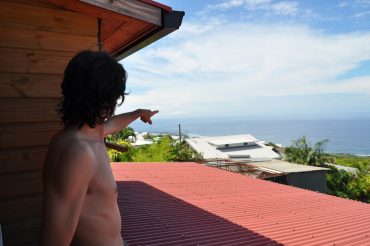 The tragic episode of shark attacks and the banning of marine activities have brought 40 glorious years of surf development in Réunion Island to a brutal stop. “It all started in the 1970s”, says Vincent Zerbone, who volunteers for the association Prévention Requin Reunion. Its goal is to “reduce the risks of marine and coastal activities, mainly of shark attacks”. He invited me for a chat at his home, a nice little house in the hills between Saint-Leu and Étang-Salé. The terrace offers a breath-taking view of the sea and several surf spots that are all forbidden today. I can’t think of a worse torture for a surfer. Vincent arrived from mainland France in 2002 when he was 27 years old and already passionate about surfing. When he saw how the “shark crisis” was affecting his adoptive island, he decided he wasn’t going to sit back, so he joined PRR. We talk about the history of marine activities in Réunion Island. He says: “Until the 1960s, the island was underdeveloped and life was tough, to say the least. People lived with very few means, often in small huts made of wood and corrugated metal. You can’t say they were looking forward to a fun weekend at the beach. Hobbies simply didn’t exist.”
The tragic episode of shark attacks and the banning of marine activities have brought 40 glorious years of surf development in Réunion Island to a brutal stop. “It all started in the 1970s”, says Vincent Zerbone, who volunteers for the association Prévention Requin Reunion. Its goal is to “reduce the risks of marine and coastal activities, mainly of shark attacks”. He invited me for a chat at his home, a nice little house in the hills between Saint-Leu and Étang-Salé. The terrace offers a breath-taking view of the sea and several surf spots that are all forbidden today. I can’t think of a worse torture for a surfer. Vincent arrived from mainland France in 2002 when he was 27 years old and already passionate about surfing. When he saw how the “shark crisis” was affecting his adoptive island, he decided he wasn’t going to sit back, so he joined PRR. We talk about the history of marine activities in Réunion Island. He says: “Until the 1960s, the island was underdeveloped and life was tough, to say the least. People lived with very few means, often in small huts made of wood and corrugated metal. You can’t say they were looking forward to a fun weekend at the beach. Hobbies simply didn’t exist.”
Things started to change with the arrival of the first wealthy expatriates from France, who brought the concept of free time and their suitcases overflowing with fun activities. Suddenly, people discovered water sports such as spearfishing. “The first photos and stories began to appear in the 1970s, adds Vincent Zerbone. Similarly to so many other coastal communities around the world, the people on the west coast of Réunion Island began enjoying the bountiful ocean. It became a part of their everyday life.”
Mystery surrounds the very first surfers to discover the island’s formidable potential. Some say they were French, other believe they were Australian, or New Zealanders or even South African. Mick Asprey, known as Mickey “Rat”, is a 70-year-old Australian who first visited Réunion Island in 1972. Today, he owns a surf shop in Saint-Leu, on the west coast. When I ask him if he knows the name of the pioneers, he answers that “there are many rumors, but no proofs.” He proceeds to tell me one of these “good old days” stories: “In the 1970s, the neighboring island of Mauritius had all the fame in the Australian surfing world. Wrongly, because the Mauritian waves are very dangerous and far from the coast. Many Australians made the journey because of the stories of perfection they heard at home, except they hardly didn’t score once they got there. As they returned to their families and friends, frustrated, they spread fake tales of discoveries and all-time conditions. Here in Réunion, it was the exact opposite. We found the Left of Saint-Leu, a wave of rare quality, perfect and close to shore. We tried to keep it a secret, but in the 1980s, the Basque couldn’t hold their tongue and soon all their mates were coming here. Once the word was out, there was no coming back.”
The Left of Saint-Leu quickly became “world-class” and its reputation drew the crowds. It became harder and harder to enjoy a calm session and catch one of those perfect waves. In order to escape the masses and for the spirit of adventure, explorers went prospecting the rest of Réunion’s coast. Quickly, they discovered that surfing was possible almost everywhere. Yet, in the North, East and South, the activity is not for the faint of heart. The powerful waves usually break on sharp lava rock. And there are lots of predators. “Sharks have always been in the picture, says Vincent Zerbone. People had identified the sketchy spots, such as the Pic du Diable, or in the Wild South as we call it.”
Back on the West coast, surfing is almost too good to be true. “When I arrived in 2002, remembers the surfer from Étang-Salé, I shared a house with several friends in front of the spot of Trois Bassins. Our whole lives revolved around the ocean. Groups of friends would come over in the morning with bags of croissants, and it was game on. We would paddle out at any time of the day. No matter if the water was clear, or if it was murky as hell from the pouring rain. There were often daring contests to go surfing at night.” I heard the same stories from several people, such as Patrick Flores: “I grew up in Boucan Canot, and we used to make these big bone fires on the beach and go surfing at night. We got really excited during the cyclone season, when large swell would light up all of the spots on the coast. The cyclones would also bring pouring rain, and the gorges would spit out so many freshwater and mud that the ocean water turned into chocolate milk.”
World-class waves, palm trees, corals, year-round warm waters, French girls on the beach and croissants for breakfast: difficult to paint a better picture, even though the risks were always there. Elodie Marais, born and raised on Réunion Island, is Vincent Zerbone’s partner. She tells me why sharks aren’t her friends: “When I was young, there were only two other bodyboarder girls with me on the island, it was terrific. We used to skip school to go surfing. In 1996, I was 16 years old and we paddled out at a spot near Étang-Salé. A large hammerhead shark bumped into me, and I freaked out. The other five friends who were out with me all laughed and stayed in the water. That was it for me, I haven’t surfed since.”
“Bumpings” and sightings were regular on the west coast of Réunion Island, but bites were so rare that dedicated shops and surf schools started mushrooming in the beach towns. The sport became part of the local culture, and kids started practicing at a very young age, coached by parents and professionals. Fantastic potentials were discovered, and today the best-ranked French surfer, Jeremy Flores, is from Réunion Island. In June 2016, Johanne Defay won the world tour stop in Fiji, in a wave quite similar to the Left of Saint-Leu. The shore break of Étang-Salé is where she stood up on a board for the first time. Amaurhy Laverne who is famous for his two bodyboard world titles practiced his art in the waves of “Zoreil-Land” since a young age. All things considered, the island deserved its original nickname of “Small French Hawaii”.
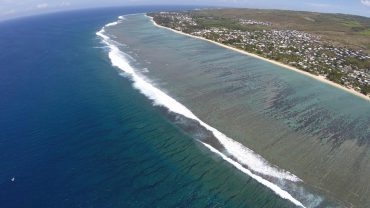 When the swell was pumping and waves were breaking along Réunion’s coast, all this thriving community would grab their boards and paddle out. But when the ocean would go flat for days or weeks, people still got wet. “The majority of surfers are also outstanding swimmers, fishermen and spear fishermen, says Vincent Zerbone. Their daily lives were spent in and around the ocean, like so many others around the world. These guys that were in the water all day every day started noticing subtle changes.” With their mask, tuba, flippers and spear guns, they saw a worrying shift in the ecology. Between 2005 and 2010, the spear fishermen began noticing bull sharks on a regular basis, in a territory usually occupied by reef sharks. In 2008, Saint-Paul’s lifesavers even wrote to the public authorities to express how worried they were after observing a growing number of large predators in the popular bathing areas. Nothing was done, to prevent “fueling the psychosis”.
When the swell was pumping and waves were breaking along Réunion’s coast, all this thriving community would grab their boards and paddle out. But when the ocean would go flat for days or weeks, people still got wet. “The majority of surfers are also outstanding swimmers, fishermen and spear fishermen, says Vincent Zerbone. Their daily lives were spent in and around the ocean, like so many others around the world. These guys that were in the water all day every day started noticing subtle changes.” With their mask, tuba, flippers and spear guns, they saw a worrying shift in the ecology. Between 2005 and 2010, the spear fishermen began noticing bull sharks on a regular basis, in a territory usually occupied by reef sharks. In 2008, Saint-Paul’s lifesavers even wrote to the public authorities to express how worried they were after observing a growing number of large predators in the popular bathing areas. Nothing was done, to prevent “fueling the psychosis”.
In his book “Requins à la Réunion, une tragédie moderne” (Sharks in Réunion, a modern tragedy), the author Jean-François Nativel, surfer and spear fisherman from Saint-Paul, explains his role as a whistle-blower. He details all of his encounters with what he believes to be the same bull shark. In the beginning of 2011, the animal went from shy to inquisitive in a matter of months.
Then, as if to validate all the worrying signs of the past years, the first accident took place on Saturday February 19th, 2011. In front of the popular beach of Roches Noires in Saint-Gilles, in crystal clear waters, Eric Dargent was attacked. The surfer from mainland France was visiting friends on the island. The bull shark tore his left leg off at around 6 pm. Despite such a dreadful injury, he survived, and he even found the strength to start surfing again many months later with a state-of-the-art prosthesis that he helped develop.
After this first attack, the risk became unacceptable for Jean-François Nativel, who had surfed three days earlier with his kids only 200 meters from the spot where Dargent was attacked. Along with some friends and professional fishermen, they decided to hunt down the dangerous animal. Late at night and after many long hours, they came back to port with a large dead bull shark. Journalists and photographs were present to take pictures, and the next day, the newspaper’s headline read “The shark of Roches Noires captured”. The unilateral action, first widely praised and later criticized, sparked a moderate controversy. The professional fisherman ended up being prosecuted and sentenced to pay a symbolic fine.
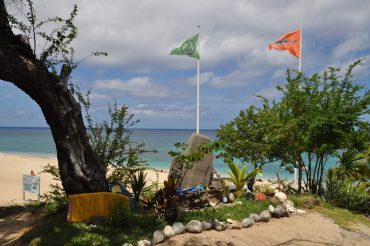 Weeks ended up passing by, and the initial shock of Dargent’s accident as well as the culling’s controversy slowly faded away. But on the 15th of June, the horror made a brutal comeback in paradise. Boucan Canot, Patrick Flores’ home beach, is badly hit. “This is the beach where I grew up and spent all of my time, he tells me, and I just couldn’t believe a shark attack could happen there, let alone a fatal one. It was plainly inconceivable until Eddy Aubert was killed in June 2011.” The weather had been bad for days, and the rain had steadily transformed the water in a brown soup. It was getting close to sunset when the accident took place. The 31-year-old surfer didn’t stand a chance, as the autopsy revealed several violent injuries. He was already dead when the waves dropped his body on the sand.
Weeks ended up passing by, and the initial shock of Dargent’s accident as well as the culling’s controversy slowly faded away. But on the 15th of June, the horror made a brutal comeback in paradise. Boucan Canot, Patrick Flores’ home beach, is badly hit. “This is the beach where I grew up and spent all of my time, he tells me, and I just couldn’t believe a shark attack could happen there, let alone a fatal one. It was plainly inconceivable until Eddy Aubert was killed in June 2011.” The weather had been bad for days, and the rain had steadily transformed the water in a brown soup. It was getting close to sunset when the accident took place. The 31-year-old surfer didn’t stand a chance, as the autopsy revealed several violent injuries. He was already dead when the waves dropped his body on the sand.
The whole island woke up in a state of shock, but the surfer’s responsibility was overwhelming. Shark attacks are known to happen more often in murky waters, and at dusk. Aubert’s accident was blamed on his recklessness. The whistle-blowers’ warnings were all lost in the speeches aimed at minimizing the incident. Three weeks later, nothing was said or done when a kid saw his bodyboard cut in half by a bull shark, in the middle of the day, in crystal clear waters of Roches Noires beach. He swam back to shore without a scratch.
Others won’t have his luck.
